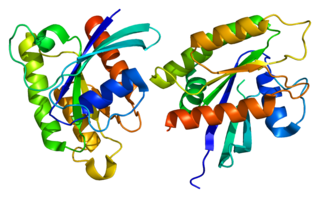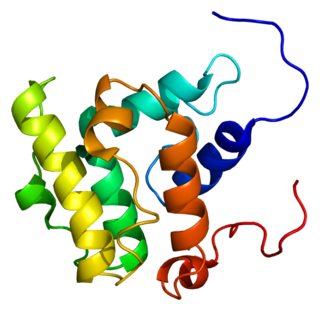NUAK family SNF1-like kinase 1 also known as AMPK-related protein kinase 5 (ARK5) is an enzyme that in humans is encoded by the NUAK1 gene. [5] [6] [7]
NUAK family SNF1-like kinase 1 also known as AMPK-related protein kinase 5 (ARK5) is an enzyme that in humans is encoded by the NUAK1 gene. [5] [6] [7]
Acts as a regulator of cellular senescence and cellular ploidy by mediating phosphorylation of 'Ser-464' of LATS1, thereby controlling its stability. Controls cell adhesion by regulating activity of the myosin protein phosphatase 1 (PP1) complex. [8]
ARK5 is important in tumor malignancy and invasiveness. [9]
ARK5 is often overexpressed in multiple myeloma cell lines. [10] [11] ARK5 promotes tumor cell survival under regulation by Akt. [9]
ARK5 increases MT1-MMP production. [9] (MT1-MMP activates MMP-2 and MMP-9 which are involved in tumor metastasis. [9] )
ON123300 (a CDK4 inhibitor), also inhibits ARK5 and reduces proliferation of multiple myeloma and mantle cell lymphoma cell lines. [10]
NUAK1 has been shown to interact with USP9X [12] and Ubiquitin C. [12]

The proto-oncogene c-Rel is a protein that in humans is encoded by the REL gene. The c-Rel protein is a member of the NF-κB family of transcription factors and contains a Rel homology domain (RHD) at its N-terminus and two C-terminal transactivation domains. c-Rel is a myeloid checkpoint protein that can be targeted for treating cancer. c-Rel has an important role in B-cell survival and proliferation. The REL gene is amplified or mutated in several human B-cell lymphomas, including diffuse large B-cell lymphoma and Hodgkin's lymphoma.

Death receptor 4 (DR4), also known as TRAIL receptor 1 (TRAILR1) and tumor necrosis factor receptor superfamily member 10A (TNFRSF10A), is a cell surface receptor of the TNF-receptor superfamily that binds TRAIL and mediates apoptosis.

CBL-B is an E3 ubiquitin-protein ligase that in humans is encoded by the CBLB gene. CBLB is a member of the CBL gene family.

Tyrosine-protein kinase 6 is an enzyme that in humans is encoded by the PTK6 gene.

Cytoplasmic tyrosine-protein kinase BMX is an enzyme that in humans is encoded by the BMX gene.

MAP kinase-activating death domain protein is an enzyme that in humans is encoded by the MADD gene. MADD is one out of four of the splice variants of the human IG20 (insulinoma-glucagonoma clone 20) gene which is located on human chromosome 11.

Ras-related protein R-Ras2 is a protein that in humans is encoded by the RRAS2 gene.

Tribbles homolog 3 is a protein that in humans is encoded by the TRIB3 gene.

Wiskott–Aldrich syndrome protein family member 3 is a protein that in humans is encoded by the WASF3 gene.

Cell division protein kinase 3 is an enzyme that in humans is encoded by the CDK3 gene.

Sprouty-related, EVH1 domain-containing protein 2 is a protein that in humans is encoded by the SPRED2 gene.

Ribosomal protein S6 kinase alpha-4 is an enzyme that in humans is encoded by the RPS6KA4 gene.

Serine/threonine-protein kinase PLK2 is an enzyme that in humans is encoded by the PLK2 gene.

Large tumor suppressor kinase 2 (LATS2) is an enzyme that in humans is encoded by the LATS2 gene.

Guanine nucleotide exchange factor VAV3 is a protein that in humans is encoded by the VAV3 gene.

Maternal embryonic leucine zipper kinase (MELK) is an enzyme that in humans is encoded by the MELK gene. MELK is a serine/threonine kinase belonging to the family of AMPK/Snf1 protein kinases. MELK was first identified present as maternal mRNA in mouse embryos. MELK expression is elevated in a number of cancers and is an active research target for pharmacological inhibition.

Membrane-associated guanylate kinase, WW and PDZ domain-containing protein 3 is an enzyme that in humans is encoded by the MAGI3 gene.

Serine/threonine-protein kinase 38-like is an enzyme that in humans is encoded by the STK38L gene.

Lethal(2) giant larvae protein homolog 1 is a protein that in humans is encoded by the LLGL1 gene.

T-cell leukemia/lymphoma protein 1B is a protein that in humans is encoded by the TCL1B gene.